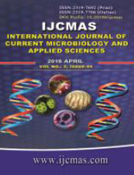


 National Academy of Agricultural Sciences (NAAS)
National Academy of Agricultural Sciences (NAAS)

|
PRINT ISSN : 2319-7692
Online ISSN : 2319-7706 Issues : 12 per year Publisher : Excellent Publishers Email : editorijcmas@gmail.com / submit@ijcmas.com Editor-in-chief: Dr.M.Prakash Index Copernicus ICV 2018: 95.39 NAAS RATING 2020: 5.38 |
Soil is the soul of immeasurable life. It is being polluted by various organic and inorganic pollutants due to hasty urbanization and industrialization; it has led to increased dumping of heavy metals and radionuclide into the surroundings. Remediation is a main solution to solve the problem. There is a critical need for sprouting a comprehensive soil protection policy based on precautionary, analytical and therapeutic instruments, which are legally implemented. Restrictive and clean up measures to avoid hazards from contaminated soil belong to the curative soil protection. Bioremediation is a method, which uses indigenous micro flora or added specific microorganisms to help in biodegradation of pollutants and recovery of land and ground water. There are also numerous constraints, which should be overcome to use their method successfully as a tool for remediation of contaminated soils. When a microbiological methods are used to remove the complex polymers into the less dangerous forms are known as biodegradation, and in turn utilized by them as a source of energy.
 |
 |
 |
 |
 |